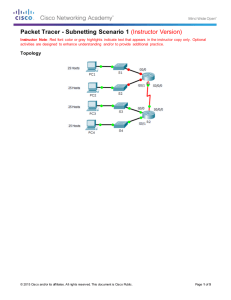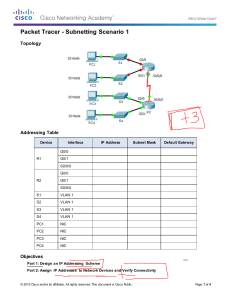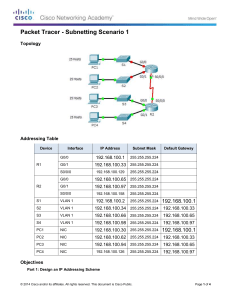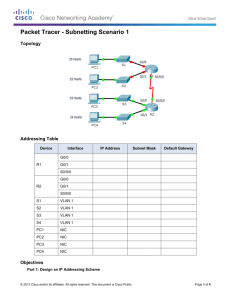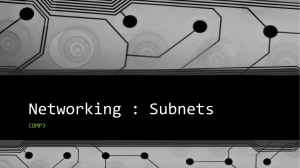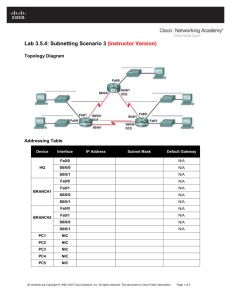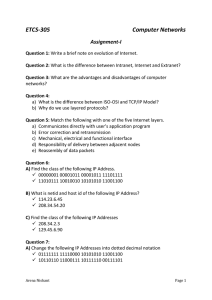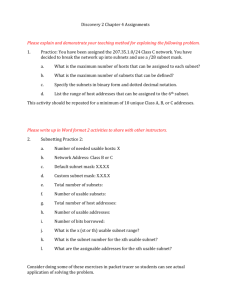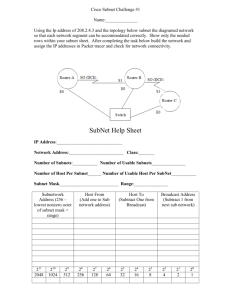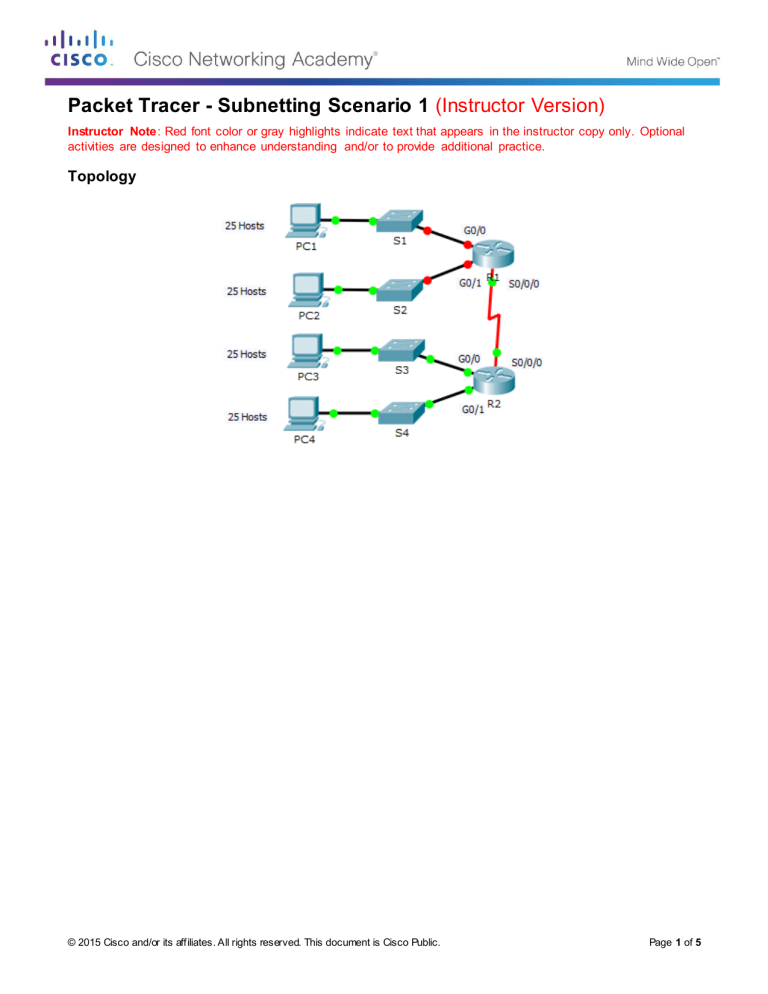
Packet Tracer - Subnetting Scenario 1 (Instructor Version)
Instructor Note: Red font color or gray highlights indicate text that appears in the instructor copy only. Optional
activities are designed to enhance understanding and/or to provide additional practice.
Topology
© 2015 Cisco and/or its affiliates. All rights reserved. This document is Cisco Public.
Page 1 of 5
Packet Tracer - Subnetting Scenario 1
Addressing Table
Device
Interface
IP Address
Subnet Mask
Default Gateway
G0/0
192.168.100.1
255.255.255.224
N/A
G0/1
192.168.100.33
255.255.255.224
N/A
S0/0/0
192.168.100.129
255.255.255.224
N/A
G0/0
192.168.100.65
255.255.255.224
N/A
G0/1
192.168.100.97
255.255.255.224
N/A
S0/0/0
192.168.100.158
255.255.255.224
N/A
S1
VLAN 1
192.168.100.2
255.255.255.224
192.168.100.1
S2
VLAN 1
192.168.100.34
255.255.255.224
192.168.100.33
S3
VLAN 1
192.168.100.66
255.255.255.224
192.168.100.65
S4
VLAN 1
192.168.100.98
255.255.255.224
192.168.100.97
PC1
NIC
192.168.100.30
255.255.255.224
192.168.100.1
PC2
NIC
192.168.100.62
255.255.255.224
192.168.100.33
PC3
NIC
192.168.100.94
255.255.255.224
192.168.100.65
PC4
NIC
192.168.100.126
255.255.255.224
192.168.100.97
R1
R2
Objectives
Part 1: Design an IP Addressing Scheme
Part 2: Assign IP Addresses to Network Devices and Verify Connectivity
Scenario
In this activity, you are given the network address of 192.168.100.0/24 to subnet and provide the IP
addressing for the network shown in the topology. Each LAN in the network requires enough space for, at
least, 25 addresses for end devices, the switch and the router. The connection between R1 to R2 will require
an IP address for each end of the link.
Part 1: Design an IP Addressing Scheme
Step 1: Subnet the 192.168.100.0/24 network into the appropriate number of subnets.
a.
Based on the topology, how many subnets are needed? 5
b.
How many bits must be borrowed to support the number of subnets in the topology table? 3
c.
How many subnets does this create? 8
d.
How many usable hosts does this create per subnet? 30
Note: If your answer is less than the 25 hosts required, then you borrowed too many bits.
e.
Calculate the binary value for the first five subnets. The first subnet is already shown.
Net 0: 192 . 168 . 100 .
0
0
0
0
0
© 2015 Cisco and/or its affiliates. All rights reserved. This document is Cisco Public.
0
0
0
Page 2 of 5
Packet Tracer - Subnetting Scenario 1
Net 1: 192 . 168 . 100 . ___ ___ ___ ___ ___ ___ ___ ___
Net 1: 192 . 168 . 100 . 0
0
1
0
0
0
0
0
Net 2: 192 . 168 . 100 . ___ ___ ___ ___ ___ ___ ___ ___
Net 2: 192 . 168 . 100 . 0
1
0
0
0
0
0
0
Net 3: 192 . 168 . 100 . ___ ___ ___ ___ ___ ___ ___ ___
Net 3: 192 . 168 . 100 . 0
1
1
0
0
0
0
0
Net 4: 192 . 168 . 100 . ___ ___ ___ ___ ___ ___ ___ ___
Net 4: 192 . 168 . 100 . 1
0
0
0
0
0
0
0
f.
Calculate the binary and decimal value of the new subnet mask.
11111111.11111111.11111111. ___ ___ ___ ___ ___ ___ ___ ___
11111111.11111111.111111111. 1
1
1
0
0
0
0
0
255 .
255 .
255 . ______
255 .
255 .
255 . 224
g.
Fill in the Subnet Table, listing the decimal value of all available subnets, the first and last usable host
address, and the broadcast address. Repeat until all addresses are listed.
Note: You may not need to use all rows.
Subnet Table
Subnet
Number
Subnet Address
First Usable
Host Address
Last Usable
Host Address
Broadcast Address
0
192.168.100.0
192.168.100.1
192.168.100.30
192.168.100.31
1
192.168.100.32
192.168.100.33
192.168.100.62
192.168.100.63
2
192.168.100.64
192.168.100.65
192.168.100.94
192.168.100.95
3
192.168.100.96
192.168.100.97
192.168.100.126
192.168.100.127
4
192.168.100.128
192.168.100.129
192.168.100.158
192.168.100.159
5
192.168.100.160
192.168.100.161
192.168.100.190
192.168.100.191
6
192.168.100.192
192.168.100.193
192.168.100.222
192.168.100.223
7
192.168.100.224
192.168.100.225
192.168.100.254
192.168.100.255
8
9
10
Step 2: Assign the subnets to the network shown in the topology.
a.
Assign Subnet 0 to the LAN connected to the GigabitEthernet 0/0 interface of R1: 192.168.100.0 /27
b.
Assign Subnet 1 to the LAN connected to the GigabitEthernet 0/1 interface of R1: 192.168.100.32 /27
© 2015 Cisco and/or its affiliates. All rights reserved. This document is Cisco Public.
Page 3 of 5
Packet Tracer - Subnetting Scenario 1
c.
Assign Subnet 2 to the LAN connected to the GigabitEthernet 0/0 interface of R2: 192.168.100.64 /27
d.
Assign Subnet 3 to the LAN connected to the GigabitEthernet 0/1 interface of R2: 192.168.100.96 /27
e.
Assign Subnet 4 to the WAN link between R1 to R2: 192.168.100.128 /27
Step 3: Document the addressing scheme.
Fill in the Subnet Table using the following guidelines:
a.
Assign the first usable IP addresses to R1 for the two LAN links and the WAN link.
b.
Assign the first usable IP addresses to R2 for the LANs links. Assign the last usable IP address for the
WAN link.
c.
Assign the second usable IP addresses to the switches.
d.
Assign the last usable IP addresses to the hosts.
Part 2: Assign IP Addresses to Network Devices and Verify Connectivity
Most of the IP addressing is already configured on this network. Implement the following steps to complete
the addressing configuration.
Step 1: Configure IP addressing on R1 LAN interfaces.
Step 2: Configure IP addressing on S3, including the default gateway.
Step 3: Configure IP addressing on PC4, including the default gateway.
Step 4: Verify connectivity.
You can only verify connectivity from R1, S3, and PC4. However, you should be able to ping every IP address
listed in the Addressing Table.
Suggested Scoring Rubric
Note: The majority of points are allocated to designing and documenting the addressing scheme. Implementation
of the addresses in Packet Tracer is of minimal consideration.
© 2015 Cisco and/or its affiliates. All rights reserved. This document is Cisco Public.
Page 4 of 5
Packet Tracer - Subnetting Scenario 1
Question
Location
Possible
Points
Step 1a
1
Step 1b
1
Step 1c
1
Step 1d
1
Step 1e
4
Step 1f
2
Step 1g
10
Assign Subnets
Step 2
10
Document Addressing
Step 3
40
Activity Section
Part 1: Design an IP
Addressing Scheme
Complete Subnet Table
Part 1 Total
70
Packet Tracer Score
30
Total Score
© 2015 Cisco and/or its affiliates. All rights reserved. This document is Cisco Public.
Earned
Points
100
Page 5 of 5

